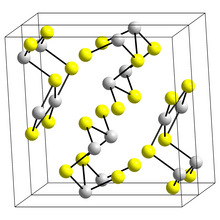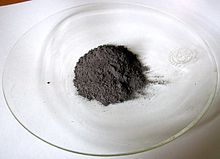
| |

| |
| Names | |
|---|---|
| IUPAC names
Antimony(III) sulfide Diantimony trisulfide | |
Other names
| |
| Identifiers | |
| CAS Number | |
| 3D model (JSmol) | |
| ChemSpider | |
| ECHA InfoCard | 100.014.285 |
| PubChem CID | |
| UNII | |
| CompTox Dashboard (EPA) | |
InChI
| |
SMILES
| |
| Properties | |
| Chemical formula | Sb2S3 |
| Molar mass | 339.70 g·mol |
| Appearance | Grey or black orthorhombic crystals (stibnite) |
| Density | 4.562g cm (stibnite) |
| Melting point | 550 °C (1,022 °F; 823 K) (stibnite) |
| Boiling point | 1,150 °C (2,100 °F; 1,420 K) |
| Solubility in water | 0.00017 g/(100 mL) (18 °C) |
| Magnetic susceptibility (χ) | −86.0·10 cm/mol |
| Refractive index (nD) | 4.046 |
| Thermochemistry | |
| Heat capacity (C) | 123.32 J/(mol·K) |
| Std enthalpy of formation (ΔfH298) |
−157.8 kJ/mol |
| Hazards | |
| NFPA 704 (fire diamond) |
 |
| Lethal dose or concentration (LD, LC): | |
| LD50 (median dose) | > 2000 mg/kg (rat, oral) |
| NIOSH (US health exposure limits): | |
| PEL (Permissible) | TWA 0.5 mg/m (as Sb) |
| REL (Recommended) | TWA 0.5 mg/m (as Sb) |
| Related compounds | |
| Other anions | |
| Other cations | Arsenic trisulfide Bismuth(III) sulfide |
| Related compounds | Antimony pentasulfide |
| Except where otherwise noted, data are given for materials in their standard state (at 25 °C , 100 kPa). Infobox references | |
Antimony trisulfide (Sb2S3) is found in nature as the crystalline mineral stibnite and the amorphous red mineral (actually a mineraloid) metastibnite. It is manufactured for use in safety matches, military ammunition, explosives and fireworks. It also is used in the production of ruby-colored glass and in plastics as a flame retardant. Historically the stibnite form was used as a grey pigment in paintings produced in the 16th century. In 1817, the dye and fabric chemist, John Mercer discovered the non-stoichiometric compound Antimony Orange (approximate formula Sb2S3·Sb2O3), the first good orange pigment available for cotton fabric printing.
Antimony trisulfide was also used as the image sensitive photoconductor in vidicon camera tubes. It is a semiconductor with a direct band gap of 1.8–2.5 eV. With suitable doping, p and n type materials can be produced.
Preparation and reactions
Sb2S3 can be prepared from the elements at temperature 500–900 °C:
- 2 Sb + 3 S → Sb2S3
Sb2S3 is precipitated when H2S is passed through an acidified solution of Sb(III). This reaction has been used as a gravimetric method for determining antimony, bubbling H2S through a solution of Sb(III) compound in hot HCl deposits an orange form of Sb2S3 which turns black under the reaction conditions.
Sb2S3 is readily oxidised, reacting vigorously with oxidising agents. It burns in air with a blue flame. It reacts with incandescence with cadmium, magnesium and zinc chlorates. Mixtures of Sb2S3 and chlorates may explode.
In the extraction of antimony from antimony ores the alkaline sulfide process is employed where Sb2S3 reacts to form thioantimonate(III) salts (also called thioantimonite):
- 3 Na2S + Sb2S3 → 2 Na3SbS3
A number of salts containing different thioantimonate(III) ions can be prepared from Sb2S3. These include:
- [SbS3], [SbS2], [Sb2S5], [Sb4S9], [Sb4S7] and [Sb8S17]
Schlippe's salt, Na3SbS4·9H2O, a thioantimonate(V) salt is formed when Sb2S3 is boiled with sulfur and sodium hydroxide. The reaction can be represented as:
- Sb2S3 + 3 S + 2 S → 2 [SbS4]
Structure
The structure of the black needle-like form of Sb2S3, stibnite, consists of linked ribbons in which antimony atoms are in two different coordination environments, trigonal pyramidal and square pyramidal. Similar ribbons occur in Bi2S3 and Sb2Se3. The red form, metastibnite, is amorphous. Recent work suggests that there are a number of closely related temperature dependent structures of stibnite which have been termed stibnite (I) the high temperature form, identified previously, stibnite (II) and stibnite (III). Other paper shows that the actual coordination polyhedra of antimony are in fact SbS7, with (3+4) coordination at the M1 site and (5+2) at the M2 site. These coordinations consider the presence of secondary bonds. Some of the secondary bonds impart cohesion and are connected with packing.
References
- ^ Haynes, W. M., ed. (2014). CRC Handbook of Chemistry and Physics (95th ed.). Boca Raton, FL: CRC Press. pp. 4–48. ISBN 978-1-4822-0867-2.
- ^ NIOSH Pocket Guide to Chemical Hazards. "#0036". National Institute for Occupational Safety and Health (NIOSH).
- "Metastibnite".
- SUPERGENE METASTIBNITE FROM MINA ALACRAN, PAMPA LARGA, COPIAPO, CHILE, Alan H Clark, THE AMERICAN MINERALOGIST. VOL. 55., 1970
- ^ Greenwood, Norman N.; Earnshaw, Alan (1997). Chemistry of the Elements (2nd ed.). Butterworth-Heinemann. pp. 581–582. ISBN 978-0-08-037941-8.
- Eastaugh, Nicholas (2004). Pigment Compendium: A Dictionary of Historical Pigments. Butterworth-Heinemann. p. 359. ISBN 978-0-7506-5749-5.
- Parnell, Edward A (1886). The life and labours of John Mercer. London: Longmans, Green & Co. p. 23.
- Electrochemistry of Metal Chalcogenides, Mirtat Bouroushian, Springer, 2010
- ^ Holleman, Arnold Frederik; Wiberg, Egon (2001), Wiberg, Nils (ed.), Inorganic Chemistry, translated by Eagleson, Mary; Brewer, William, San Diego/Berlin: Academic Press/De Gruyter, p. 765-766, ISBN 0-12-352651-5
- A.I. Vogel, (1951), Quantitative Inorganic analysis, (2d edition), Longmans Green and Co
- Hazardous Laboratory Chemicals Disposal Guide, Third Edition, CRC Press, 2003, Margaret-Ann Armour, ISBN 9781566705677
- Anderson, Corby G. (2012). "The metallurgy of antimony". Chemie der Erde - Geochemistry. 72: 3–8. Bibcode:2012ChEG...72....3A. doi:10.1016/j.chemer.2012.04.001. ISSN 0009-2819.
- Inorganic Reactions and Methods, The Formation of Bonds to Group VIB (O, S, Se, Te, Po) Elements (Part 1) (Volume 5) Ed. A.P, Hagen,1991, Wiley-VCH, ISBN 0-471-18658-9
- Wells A.F. (1984) Structural Inorganic Chemistry 5th edition Oxford Science Publications ISBN 0-19-855370-6
- Kuze S., Du Boulay D., Ishizawa N., Saiki A, Pring A.; (2004), X ray diffraction evidence for a monoclinic form of stibnite, Sb2S3, below 290K; American Mineralogist, 9(89), 1022-1025.
- Kyono, A.; Kimata, M.; Matsuhisa, M.; Miyashita, Y.; Okamoto, K. (2002). "Low-temperature crystal structures of stibnite implying orbital overlap of Sb 5s 2 inert pair electrons". Physics and Chemistry of Minerals. 29 (4): 254–260. Bibcode:2002PCM....29..254K. doi:10.1007/s00269-001-0227-1. S2CID 95067785.
| Antimony compounds | |||
|---|---|---|---|
| Antimonides | |||
| Sb(III) |
| ||
| Sb(III,V) | |||
| Sb(V) |
| ||
| Sulfides (S) | ||||||||||||||||||||||||||||||||||||||||||||||||||||||||||||||||||||||||||||||||||||||||||||||||||||||||||||||||||||||||||||||||||||||||||||||||||||||||||||||||||||
|---|---|---|---|---|---|---|---|---|---|---|---|---|---|---|---|---|---|---|---|---|---|---|---|---|---|---|---|---|---|---|---|---|---|---|---|---|---|---|---|---|---|---|---|---|---|---|---|---|---|---|---|---|---|---|---|---|---|---|---|---|---|---|---|---|---|---|---|---|---|---|---|---|---|---|---|---|---|---|---|---|---|---|---|---|---|---|---|---|---|---|---|---|---|---|---|---|---|---|---|---|---|---|---|---|---|---|---|---|---|---|---|---|---|---|---|---|---|---|---|---|---|---|---|---|---|---|---|---|---|---|---|---|---|---|---|---|---|---|---|---|---|---|---|---|---|---|---|---|---|---|---|---|---|---|---|---|---|---|---|---|---|---|---|---|
| ||||||||||||||||||||||||||||||||||||||||||||||||||||||||||||||||||||||||||||||||||||||||||||||||||||||||||||||||||||||||||||||||||||||||||||||||||||||||||||||||||||